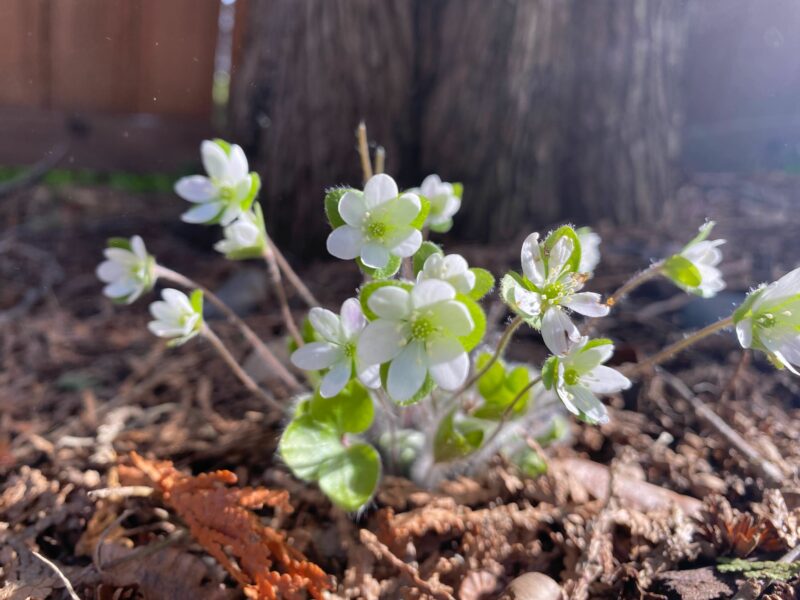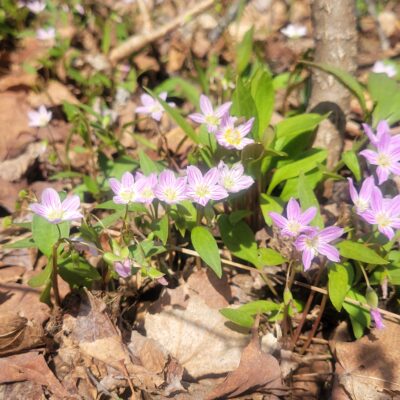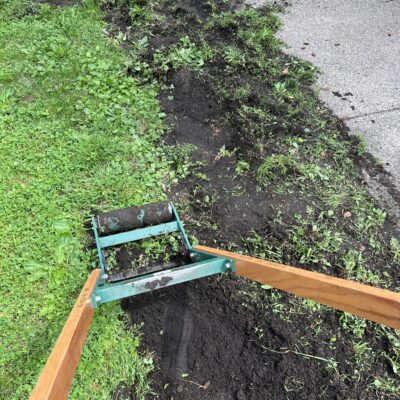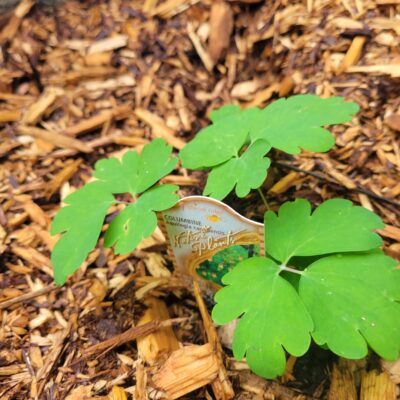
Spring is finally here in Minnesota. Dark nights are giving way to longer days and slushy snowscapes yield to grounds budded with green. And with it comes the urge to get out in the garden. But wait! Hold off on the yard cleanup just yet. Many pollinators are still overwintering in last year’s plant material. As we gear up for the growing season, we talked with several Blue Thumb partners about the when and how of pollinator-friendly spring yard care.
When to Start Spring Cleanup
Let’s admit it: the post-winter period before spring growth can look a little messy. Last year’s soggy leaves carpet the muddy ground, and native seed heads you may have left out for the birds are now decaying and dropping over.
But “last year’s growth is this year’s mulch,” says Nick Levine from Nick’s Natives. He suggests using a perennial garden’s own decaying foliage as mulch rather than reapplying wood mulch annually.
“Spring always begins in fits and starts, and we recommend letting your garden slowly wake up to the growing season,” says Madeleine Poling of Open Space Gardens.
For tidying up, wait until soil temperatures consistently reach 50°F, usually late April or early May in Minnesota. “This usually coincides with when dandelions are blooming,” shares Tal Simchoni of Morning Dew Gardening. This gives overwintering pollinators time to emerge from plant stalks and other nesting places.
At that point, you can cut back any dead foliage to about a foot. This can be done with a mulching mower or simply cutting plants by hand and laying the debris flat in your garden. Leave remaining debris in your perennial garden to cover the bare soil. “The layer of brown litter will soon be replaced by fresh green growth benefiting from the organic compost you’ve added to your garden,” Levine shares.
If you have an excess of dead leaf material, Poling adds, you can remove it from the base of your plants to give them some space for new growth.
Weeding and Mulching
 Spring is a great time to weed regularly. “New gardens often still have a lot of empty space between plants,” says Simchoni.
Spring is a great time to weed regularly. “New gardens often still have a lot of empty space between plants,” says Simchoni.
Weeds are easier to remove when they are small. “It’s always a good idea to get started early pulling weeds before they get too large, especially digging out any unwanted tree saplings,” says Poling, adding that moist spring soil makes weeding easier.
You can hand pull, hoe, cut, or dig weeds, Levine shares, but take steps to minimize soil disturbance. Consider using ergonomic tools to reduce strain. Levine recommends the Dutch push hoe, which allows you to stand straight and push a long-handled blade to cut weeds at the root. “It’s an excellent tool to reduce back strain during garden maintenance!”
Apply mulch or leaf litter to retain moisture and suppress further weeds from germinating. And in older gardens, replace mulch as needed (typically after year three).
Preparing a New Perennial Garden
Spring is a great time to prep a new perennial garden. Choose your site carefully — consider factors like sun exposure, soil conditions, and water drainage. Levine recommends caution when choosing a site in the following areas:
- Construction, vehicles, and foot traffic create compacted soils, which can be difficult to grow thriving plants in.
- Sidewalks, driveways, and brick structures radiate summer heat and often funnel much-needed rainwater into drains.
- Prevailing westerly winds dry out exposed soil and damage fragile plant stems.
Once you’ve selected a site, Levine shares, you can use a rope or garden hose to lay out the desired shape of your garden bed. Dig a clear edge to define the bed and install edging if you’d like.

Now you’re ready to clear any unwanted plants from the area. The method you choose will depend on the amount of time you have and the plants you are trying to remove. Manual removal with a sod-kicker is a fast but labor-intensive method that works in turfgrass areas with minimal weed pressure, while sheet mulching helps reduce heavier weed pressure and works best when you have at least several weeks to a few months to prep. At Morning Dew Gardens, Simchoni preps many sites with the following sheet mulching method:
- Remove vegetation a foot from the perimeter of your planting area (to limit encroaching weeds) and put in edging if desired.
- Add 1/2″-1″ of compost. (Consider purchasing in bulk!)
- Add cardboard or cardboard paper and 3″ of double shredded hardwood mulch. (Make sure there is enough moisture in the soil during this process—water in the cardboard if needed!)
- Leave the area alone for at least 6 weeks, and then it’s ready to plant!
Whichever site prep method you use, it’s best to avoid heavy tilling, which disrupts soil structure and encourages weeds. If you’re struggling with compacted soil, Levine recommends using a handheld core aerator to remove soil plugs and increase oxygen access for plant roots.
“When planting time comes, deeply water the bed and add two inches of leaf compost,” Levine shares. “Then it’s time to lay out plants and start digging!”
Spring is an ideal time to plant native perennials. “Spring’s cooler temperatures are great for the plants to establish themselves in the soil,” Poling explains. Check out Blue Thumb’s How to Plant a Plug video for a quick tutorial!
A Relationship with Nature

Gardening isn’t just about maintenance—it’s time you get to spend in nature. Consider your garden as an extended living space of your home, shared with birds, pollinators, and other beneficial insects.
“If you can come from a mindset of friendship, curiosity, and respect, you can develop a relationship with the plants and animals that live with you, and that can make your yard a supportive place for you, too,” shares Simchoni.
By delaying your spring cleanup, using sustainable weeding methods, and preparing new gardens with care, you create healthy habitat for pollinators and plants. “Go slow and give these insects a break,” shares Poling, “and in turn they will benefit your garden all season long!”
Need help with spring garden work? Local Blue Thumb Partners can assist with native plant installations and maintenance. Happy gardening!
Featured Blue Thumb Partners
- Morning Dew Gardening offers native garden design, installation, maintenance, and restoration services as well as hardscaping in the Twin Cities Metro Area.
- Nick’s Natives offers native ecological landscaping services including consultation, design, planting, maintenance, & restoration in the Duluth, MN area.
- Open Space Gardens offers sustainable landscape services, including native plant garden design, installation and maintenance services in the Minneapolis/St Paul region. Request a quote online for their Spring Cleanup services.
– Megan Reich, Metro Blooms Communications and Program Manager
